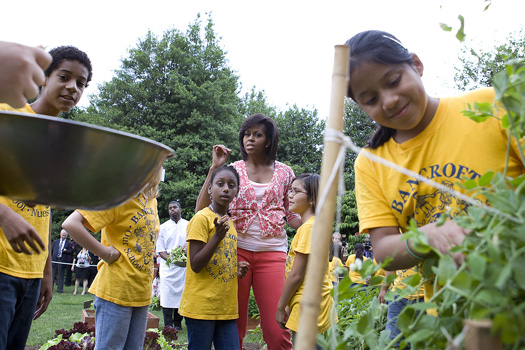 First Lady Michelle Obama hosts the Bancroft Elementary School for the garden harvest of the White House in Washington on June 16, 2009Offical White House Photographer Samantha Appleton
First Lady Michelle Obama hosts the Bancroft Elementary School for the garden harvest of the White House in Washington on June 16, 2009Offical White House Photographer Samantha Appleton
[MORE UPDATES:] Obamafoodorama looked into the issue in depth. Now the story is there’s no story. Here’s an expert commenting on the 93 PPM figure:
that number is “ridiculously low” for any urban garden, according to Dr. Gabriel Filippelli, chair of Geology at Indiana University, and associate chair of the Center for Environmental Health. Dr. Filippelli spent a lot of time chuckling during a recent conversation about the White House Kitchen Garden, because trying to make a case for grave contamination based on a test result of 93 ppm is absurd.
So there you have it. Nothing to see here. Move along.
[UPDATE:] Sounds like this sludge story is getting a bit out of hand. Let’s be clear — the sludge was used over a decade ago. It was NOT used as mulch on the White House Kitchen Garden, as some rumors are asserted. As I say below, the lead levels in the White House soil are not dangerous. I was pointed to some ag extension sites like this one which declare that levels as high as 300ppm are considered safe for vegetable growing. Let’s not get carried away people. This story is about the EPA’s allowing corporate pressure to trump science regarding sewer sludge — not that there’s anything wrong with the vegetables coming out of the White House garden. A little perspective, please.
Here’s a bit of not-so-delicious irony for you. Back when First Lady Michelle Obama planted her garden, the soil tested for slightly elevated lead levels — not necessarily dangerous, but quite a bit higher than the amount considered the “normal” background soil lead level of 10 parts per million.
Lead contamination is a fact of life that for urban gardeners, as the NYT reported in May — a hangover from the past, widespread industrial use of the toxic metal in everything from paint to gasoline to pesticides. The White House soil test results were thus shrugged off at the time as an inevitability of urban gardening. Well, Mother Jones’ Blue Marble blog speculates that there is a particular guilty party, lead-wise, for the White House lawn’s issues. And it’s that fertilizer you love to hate — sewer sludge.
Grist published a series of articles recently on the dangers of using sewer sludge on agricultural lands. Sludge tends to be full of heavy metals like lead, along with an encyclopedia’s worth of industrial chemicals and pharmaceuticals. But back in the 1980s, the EPA was trying to convince everyone how wonderfully safe and useful all the leftover poo product was. So they spread some “clean” sludge on the White House South Lawn to prove it (and reportedly continued to do so for years).
Only now we discover the sludge wasn’t quite so clean. It’s entirely possible that the EPA was aware of the lead levels, but since the South Lawn grew only ornamental and not edible plants, it wasn’t considered an issue — that kind of distinction is often made with sewer sludge. Except, as we’ve learned, garden plans change. Kinda makes you wish the EPA had paid attention to the science on the dangers of sewer sludge and didn’t fire the scientist who authored a study indicating the human health risks associated with the use of sewer sludge as fertilzier — risks which, to this day, the EPA still effectively denies.
I bet the First Lady wishes the same thing.


